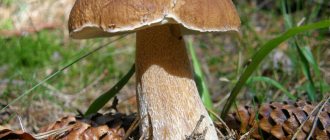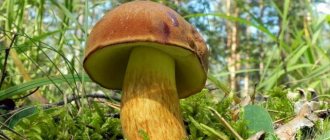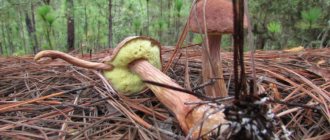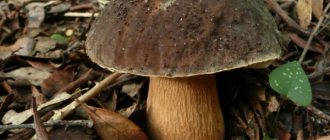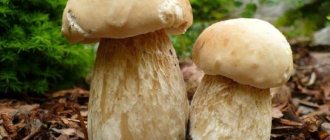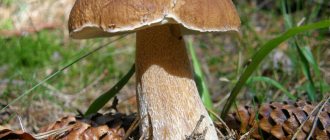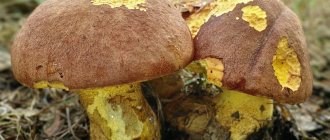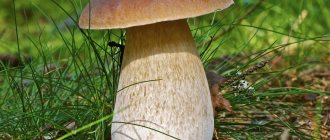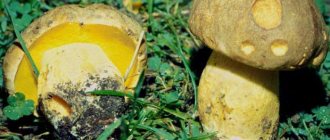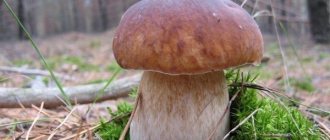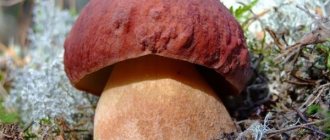Boletus adnexata (Boletus maidens)
Boletus
appendiculatus
Other names include Boletus appendiculatus, Boletus appendiculatus, Boletus maidenica, Boletus brown-yellow, Boletus shortened, or Boletus reddish .
External features
Mushroom cap
The caps of these boletus mushrooms reach a diameter of 7 to 20 cm and a thickness of about 4 cm. In young mushrooms they are semicircular, matte and fleecy-velvety, in more mature specimens they are convex and smooth, covered with tightly adherent skin.
The hats are painted in brown-yellow, brown-red and brown-brown tones.
The bottom is decorated with a golden-yellow (in young mushrooms), later - a golden-brown tubular mass. If you press on it, it turns greenish-blue.
The maiden boletus is endowed with dense, bright yellow flesh that turns blue when cut.
Ripe mushrooms form smooth, elongated, honey-colored spores in an olive-brown spore powder.
Stipe
The legs of Boletus appendix, having the shape of a club or cylinder, reach 20-30 mm in thickness and 6-12 cm in height. The surface is covered with a mesh, which disappears in mature mushrooms, and turns lemon-yellow; the bottom becomes brownish-red.
The flesh of the leg, slightly blue when touched, has a yellowish tint, closer to the ground it is brownish or brownish-pink.
Places of growth
Boletus truncata prefers moderately warm climatic conditions, limestone soils, mixed and deciduous forests with beech, hornbeam and oak. Sometimes found in mountainous areas - next to fir trees. Often found in southern European countries.
Fruiting is rare, in small groups, occurs in June - September.
Similar species
Edible
- Semi-white mushroom
. It differs from the maiden boletus in its light ocher cap, brown-black base of the leg and the smell of carbolic acid. - Boletus semi-adventitous
. It is distinguished by its white flesh and its habitat: it prefers mountain spruce forests.
Poisonous
- Rooting boletus
. The mushroom is distinguished by its light-colored caps and thicker legs. - Boletus is inedible
. It is characterized by a brighter leg and a preference for acidic fertile soil.
Edibility of the mushroom
Boletus adnexum (Boletus maidens) exudes a pleasant mushroom aroma and has an excellent taste. It can be boiled, fried, dried and canned.
agroflora.ru
Boletus appendiculatus ( lat. Boletus appendiculatus
) is a tubular, edible mushroom of the Boletus genus
of
Boletaceae
family . A rare mushroom that grows from June to September in deciduous and mixed forests.
hat
The diameter of the Boletus adnexus cap is from 70 to 200 mm. At a young age, the mushroom cap has a semicircular shape. As the mushroom ages, it becomes convex. The surface is velvety, matte, becomes bare with age, slightly longitudinally fibrous. The peel is practically not removed. The Boletus cap is appendage yellow-brown, red-brown and brown-brown in color.
The tubes are dense, up to 40 mm in length. The pores are small and rounded. The color of the tubes in young mushrooms is golden-yellow; as the mushroom ages, they become golden-brown. When pressed, they acquire a bluish-greenish tint.
Spore powder, spores
The spores are smooth, ellipsoid-fusiform. Spore size is 10-15 x 4-6 microns. They have a honey-yellow color. Spore powder is olive-brown.
Leg
Leg height from 60 to 120 mm, diameter from 20 to 30 mm, cylindrical or club-shaped. The base of the leg is conically pointed, rooted in the ground. The leg of the boletus is reticulated; as the mushroom ages, the reticulated pattern disappears. The color of the leg closer to the cap is lemon-yellow, red-brown towards the bottom.
Pulp
The pulp is dense, intense yellow. The base of the stalk is brownish or pinkish-brown. It has a pleasant mushroom taste and aroma. It turns blue when cut.
When and where does it grow?
Rare mushroom. Prefers to grow in groups of 3 to 7 pieces. Boletus adnexum is found mainly in deciduous and mixed forests from June to September. Likes to grow in regions with a moderately warm climate. Forms mycorrhiza with oaks, hornbeams and beeches. Also noted in the mountains among fir trees. The literature notes an attachment to calcareous soil.
Eating
Delicious edible mushroom. Suitable for all types of processing.
The boletus mushroom is one of the most common species of the Boletaceae family. Among the most common types of boletus are the white oak mushroom (sometimes called the reticulated boletus), the bronze boletus and the maiden boletus. All these mushrooms have long been used as food, and in our times they are a delicacy, since their distribution halo has significantly decreased.
Below you will find a photo and description of the boletus mushroom, information about where they grow and recommendations for using these mushrooms in cooking.
In cooking
The semi-white mushroom belongs to the III category of nutritional value. It has a pleasant, rich, slightly sweet taste and a subtle mushroom aroma.
The pulp is thick, fleshy, dense, elastic. It retains its texture well during cooking and does not fall apart. Based on this, there is no need to think about how to cook a semi-white mushroom - the mushroom is universal and suitable for all types of culinary processing: it can be boiled, stewed, fried.
Fried semi-white mushroom with onions, sour cream and cheese is especially tasty.
Literature:
Grunert G. Mushrooms.
Yu.G. Khatskevich. Reference guide: Mushrooms.
Udu F Mushrooms. Encyclopedia.
Description
Boletus maidens has a typical “bolete” structure. Like all boletus mushrooms, it is a large and thick mushroom with a brownish tint. Boletus adnexum is a rather rare species.
The cap of the maiden boletus is predominantly brown, but can also be gray-yellow or reddish-brown in color. Small boletus mushrooms have semicircular caps; with age, their edges open up, but the shape remains convex. The cap reaches a size of 20 cm in diameter or more. Its surface is always dry. In young specimens it is covered with fluff, in older specimens it becomes smooth.
Leg
Boletus adnexum has a greenish-yellow stalk, which becomes reddish towards the bottom. The leg is tall and moderately thick (12*3 cm in height and in diameter, respectively).
When mechanical impact is applied to the area of the leg, the latter turns blue. The bottom of the leg is pointed. The surface of the legs in young specimens is reticulated; with age, the reticulation smooths out and becomes invisible.
Spore-bearing layer
The spore layer of the boletus is very thick, represented by tubes. The ends of the tubes (pores) are small and round. Young mushrooms have a tubular layer of yellowish color, which turns brown over time. When mechanically applied to the hymenophore, it locally changes color to greenish-blue.
Spore powder
The spores of the boletus are individually large, shaped like an asymmetrical spindle, and have a warm yellow hue. The surface of the spores is smooth. The bulk of the powder is greenish-brown.
Interesting facts about the mushroom
Boletus is reddish.
Boletus appendix or maidenhair is quite rare. Therefore, it is a very successful find.
There are signs by which you can determine that a boletus is growing somewhere nearby:
- An anthill was discovered (boletus mushrooms often grow next to them).
- A fly agaric was found (they appear at the same time as boletus mushrooms).
- An interesting fact is also that boletus mushrooms can grow to very large sizes. Some specimens reach 3 kg in weight.
Boletus mushrooms are very healthy and tasty, but it is strictly not recommended for certain categories of people to eat them. These are people with allergies to mushrooms, young children (infancy and preschool age), as well as those who suffer from various gastrointestinal diseases.
Semi-bronze bolet: description and photo
| Name: | Bolet semi-bronze |
| Latin name: | Boletus subaereus |
| Type: | Edible |
| Taxonomy: |
|
Semi-bronze boletus is a rare mushroom with autumn fruiting. To find it in the forest, you should familiarize yourself with false doubles and study the features of its appearance.
What do semi-bronze boletes look like?
A mushroom with a large cap, reaching up to 17-20 cm in diameter and up to 4 cm in thickness. In young boletes it is convex, closer in shape to a ball, but as the fruiting body grows, it straightens out.
The color of the cap is gray-brown; in adult representatives, yellowish spots appear on it. In dry, hot weather it becomes covered with cracks.
On the underside of the cap, the tubular layer is white with a grayish tint. In adult representatives, it changes shade to olive green. The tubes are easily separated from the hat pulp. Their length varies between 20-40 mm.
The mushroom rises 12 cm above the ground, the thickness of the stem reaches 40 mm. It is dense, thick, similar in appearance to a mace or tuber, and has a mesh pattern. As it grows, the leg becomes more cylindrical, with a wrinkled surface, pinkish-beige, and then olive-white in color.
Where do semi-bronze boletes grow?
On the territory of the Russian Federation, bolete is rare. The main place of its growth is the southern regions, where the climate is predominantly hot with high rainfall. Semi-bronze boletus is more common in moist soils rich in humus.
Fruiting bodies are collected in mixed forests, where oak, beech, and pine trees grow. You can find both single semi-bronze boletes and small groups of 2-3 representatives.
Taste qualities of semi-bronze bolet
The mushroom is a delicacy. Gourmets appreciate it for its mild, pleasant taste. In terms of comparative characteristics, the semi-bronze bolet is superior to the porcini mushroom in terms of richness of taste and brightness. The smell of the delicacy is weak and appears after cooking. The aroma is good if the fruit body is dried.
False doubles
The semi-bronze bolet has no exact counterparts. It can be confused with other fruiting bodies due to its appearance.
The semi-bronze Polish mushroom is similar to bolet: adult representatives of the species have the same cylindrical stem and cushion-shaped cap of chocolate or chestnut shades.
To distinguish them, it is necessary to examine the fruiting body: the Polish species has white flesh that quickly turns blue when exposed to oxygen.
You can confuse the semi-bronze boletus with the bronze boletus. This one is distinguished by a darker colored cap and the absence of a mesh pattern on the stem.
It is necessary to distinguish a boletus from a gall fungus. Gorchak has a similar structure, so to recognize it, you need to study the leg. In the gall fungus it has vascular veins.
Collection rules
When choosing a location, you should study mixed forests by visiting them in August-September. The collection site should be located away from highways and industrial facilities.
Collection should be done using a sharp knife: carefully cut at the root. It is not recommended to pull out or break off fruiting bodies; there is a high risk of damage to the mycelium.
Use
Semi-bronze bolet can be eaten in any form, except raw. When cooking, after washing, housewives boil the pulp and then fry or marinate.
You can dry the fruiting bodies to use them in future recipes.
Principles of mushroom processing:
- remove all foliage and small debris from the pulp, cut off the lower part of the fruit body, rinse under running water;
- Place the mushrooms in a bowl of cold water for 15 minutes, then boil with salt for 20 minutes if you plan to fry the product, and 40 minutes if the semi-bronze bolet needs to be marinated or consumed boiled.
Conclusion
Semi-bronze boletus is usually classified as an edible mushroom. It has a delicate aroma and mild taste, and is universal in use. Its main habitat is mixed forests, where it should be distinguished from false species.
Growing boletus
Growing boletus is a painstaking task that requires patience and special conditions. Due to its biological properties, the fungus needs a close connection with the root system of trees. For successful cultivation, you need to plant spruce, pine or birch trees on the site, then you can start breeding boletus in any of three ways:
- Chopped boletus mushrooms are soaked in water for a day, mixed and filtered. The finished infusion containing boletus spores is carefully distributed under the trees.
- In the forest, separate areas of earth containing mycelium are dug up. Under the trees in the garden, small depressions are made in the soil, where the mycelium is placed and covered with forest soil. The mycelium needs moderate watering.
- The caps of overripe boletus mushrooms are cut into small slices and mixed with moistened soil, after which they are laid out under the trees.
With timely watering, you can get a harvest next year: first individual boletus mushrooms, then whole families.
Similar species
The boletus has both edible and inedible “analogues”.
Edible lookalikes:
Its difference is in a lighter cap and a black base of the stem. The smell is also different (it resembles carbolic acid).
Boletus semiadnexa
Unlike Boletus appendix, the flesh of this mushroom is not yellow, but white. In addition, it grows in thickets of spruce trees.
Among the inedible mushrooms there are also ones similar to the boletus adnexa:
Boletus root
This mushroom is thicker and lighter in color. It is considered inedible because it has a pronounced bitterness in taste, which cannot be removed either by soaking or boiling. For this reason, the mushroom is also called bitter;
Boletus is beautiful
Also called "inedible". It has a brighter leg (its upper half is yellow and the lower half is red). Like the root boletus, it is inedible due to its invincible bitterness.
No poisonous analogues are observed in Boletus adnexus. Therefore, the only thing that can happen is picking a tasteless mushroom, which is certainly unpleasant, but does not threaten life and health.
Contraindications
Despite the fact that the porcini mushroom is edible, it can also cause poisoning and there are a number of contraindications to consuming boletus mushrooms. First of all, children and pregnant women should avoid eating dishes containing porcini mushrooms. This is because mushrooms contain chitin, which is very difficult to digest and creates additional stress on the kidneys and digestive system. In addition, like any other product, boletus can cause an allergic reaction.
Contraindications to the use of porcini mushrooms:
- acute diseases of the gastrointestinal tract, liver;
- age up to 12-14 years;
- bearing a child.
You can also be poisoned by porcini mushrooms if you cook a “false porcini mushroom,” which happens very often due to unscrupulous and inexperienced mushroom pickers.
Poisonous boletus - varieties
Among the 300 known species of boletus, there are inedible and also dangerous to health representatives similar to the edible boletus:
purple boletus (Boletus purpureus)
a poisonous mushroom with a characteristic convex cap with jagged edges, covered with black spots. The pulp turns blue when cut, and after a while turns red. The mushroom grows on the calcareous soil of deciduous forests;
Photo by: Irina Ukhanova
Le Gal boletus (Boletus legaliae)
poisonous, toxic mushroom, distinguished by a smooth pinkish-orange cap. On the upper half of the leg there is a pronounced red mesh. The pulp is white or light yellow, turning blue when cut. Grows in deciduous forests of Europe;
boletus (beautiful) (Boletus calopus)
inedible mushroom, with a wrinkled, dry, matte cap. The pointed leg is lemon-yellow at the top, red in the middle, turning brown. The pulp has a bitter taste and turns blue when cut. Found everywhere in mixed forests of the European part of Russia;
beautiful boletus (Boletus pulcherrimus)
poisonous mushroom. The cap has a hemispherical shape and is reddish or olive-brown in color. The pulp is yellow, turns blue when cut. The leg is reddish-brown, has a dark red mesh underneath;
satanic mushroom (Boletus satanas)
poisonous mushroom. The cap is hemispherical in shape, the flesh is yellowish or white, and turns red or blue when cut. The leg is barrel-shaped, tapering downward. The color of the leg is red-yellowish on top, bright red or orange in the middle, and brownish-yellow below. Satanic mushroom grows in deciduous forests.
| Name: | Borovik |
| Type: | Edible |
Photos and descriptions of the boletus mushroom can often be found both in specialized literature and in many cookbooks. Few can compare in popularity with this representative of the mushroom kingdom, especially in Russia. Boletus is deservedly considered one of the most coveted trophies among mushroom pickers, not inferior in this regard to such “royal” mushrooms as saffron milk cap or white milk mushroom.
Habitat
The semi-white mushroom grows in the forest and forest-steppe zones of Europe. In the CIS, this species is not as widespread as varieties of porcini mushroom. Although it can be found in the central regions of the European part, for example, in the Moscow region, here it is quite rare and gravitates to the south. Also, the semi-white mushroom has become widespread in Polesie, the Carpathian region, the Middle Volga, Kuban - in the foothill and mountain zones.
Fruiting is not annual, but quite abundant. Prefers moist clay soils mixed with lime. The semi-white mushroom grows in small groups or singly.
Information! Recently, the semi-white mushroom has become so rare that it is close to being classified as an endangered species.
Where does it grow
The semi-white mushroom forms mycorrhiza (symbiosis with the roots of the plant), mainly with deciduous trees: oak, beech, hornbeam, and less often linden. May also occasionally be found under pine trees.
Many, especially beginners, mushroom pickers are interested in where the semi-white mushroom is collected. This species grows most often in wet floodplain deciduous, mixed, and coniferous forests.
Information! The semi-white mushroom can be grown independently in your garden plot. For this purpose, ripe fruiting bodies or mycelium brought from the forest are used. You can also buy mycelium in specialized stores.
Boletus adnexata (Boletus maidens)
Boletus appendix
–
Boletus appendiculatus
Otherwise called Ovary, Boletus maidens, Boletus brown-yellow, Boletus shortened, or Boletus reddish.
External features
Mushroom cap
The caps of these boletus mushrooms reach a diameter of 7 to 20 cm and a thickness of about 4 cm. In young mushrooms they are semicircular, matte and fleecy-velvety, in more mature specimens they are convex and smooth, covered with tightly adherent skin.
The hats are painted in brown-yellow, brown-red and brown-brown tones.
The bottom is decorated with a golden-yellow (in young mushrooms), later - a golden-brown tubular mass. If you press on it, it turns greenish-blue.
The maiden boletus is endowed with dense, bright yellow flesh that turns blue when cut.
Ripe mushrooms form smooth, elongated, honey-colored spores in an olive-brown spore powder.
Stipe
The legs of Boletus appendix, having the shape of a club or cylinder, reach 20-30 mm in thickness and 6-12 cm in height. The surface is covered with a mesh, which disappears in mature mushrooms, and turns lemon-yellow; the bottom becomes brownish-red.
The flesh of the leg, slightly blue when touched, has a yellowish tint, closer to the ground it is brownish or brownish-pink.
Places of growth
Boletus truncata prefers moderately warm climatic conditions, limestone soils, mixed and deciduous forests with beech, hornbeam and oak. Sometimes found in mountainous areas - next to fir trees. Often found in southern European countries.
Fruiting is rare, in small groups, occurs in June - September.
Similar species
Edible
- Semi-white mushroom
. It differs from the maiden boletus in its light ocher cap, brown-black base of the leg and the smell of carbolic acid. - Boletus semi-adventitous
. It is distinguished by its white flesh and its habitat: it prefers mountain spruce forests.
Poisonous
- Rooting boletus
. The mushroom is distinguished by its light-colored caps and thicker legs. - Boletus is inedible
. It is characterized by a brighter leg and a preference for acidic fertile soil.
Edibility of the mushroom
Boletus adnexum (Boletus maidens) exudes a pleasant mushroom aroma and has an excellent taste. It can be boiled, fried, dried and canned.
agroflora.ru
Boletus appendiculatus ( lat. Boletus appendiculatus
) is a tubular, edible mushroom of the Boletus genus
of
Boletaceae
family .
A rare mushroom that grows from June to September in deciduous and mixed forests.
hat
The diameter of the Boletus adnexus cap is from 70 to 200 mm. At a young age, the mushroom cap has a semicircular shape. As the mushroom ages, it becomes convex. The surface is velvety, matte, becomes bare with age, slightly longitudinally fibrous. The peel is practically not removed. The Boletus cap is appendage yellow-brown, red-brown and brown-brown in color.
The tubes are dense, up to 40 mm in length. The pores are small and rounded. The color of the tubes in young mushrooms is golden-yellow; as the mushroom ages, they become golden-brown. When pressed, they acquire a bluish-greenish tint.
Spore powder, spores
The spores are smooth, ellipsoid-fusiform. Spore size is 10-15 x 4-6 microns. They have a honey-yellow color. Spore powder is olive-brown.
Leg
Leg height from 60 to 120 mm, diameter from 20 to 30 mm, cylindrical or club-shaped. The base of the leg is conically pointed, rooted in the ground. The leg of the boletus is reticulated; as the mushroom ages, the reticulated pattern disappears. The color of the leg closer to the cap is lemon-yellow, red-brown towards the bottom.
Pulp
The pulp is dense, intense yellow. The base of the stalk is brownish or pinkish-brown. It has a pleasant mushroom taste and aroma. It turns blue when cut.
When and where does it grow?
Rare mushroom. Prefers to grow in groups of 3 to 7 pieces. Boletus adnexum is found mainly in deciduous and mixed forests from June to September. Likes to grow in regions with a moderately warm climate. Forms mycorrhiza with oaks, hornbeams and beeches. Also noted in the mountains among fir trees. The literature notes an attachment to calcareous soil.
Delicious edible mushroom. Suitable for all types of processing.
Spreading
Boletus adnexum is a rare species that prefers warm climates. Found in southern European countries. It usually grows near deciduous trees, but in mountainous areas it can grow near firs. It is known that this boletus prefers soil rich in limestone.
Boletus appendix.
The adventitious boletus grows all summer and early autumn.
Description of Boletus adnexum
The diameter of the boletus cap is 7-20 centimeters. The shape of the cap in young specimens is semicircular, becoming convex over time. The cap has a thick crumb up to 4 centimeters in size. The top skin of the cap is practically not removed. The color of the cap is red-brown, yellow-brown or brownish-brown. At first, the surface of the cap is velvety, pubescent, matte, but with age it becomes bare, slightly fibrous.
The pulp is dense, rich yellow. At the base of the stem, the color of the flesh is pink-brown or brown. In the cap above the tubes the flesh is blue, its taste and smell are pleasant. The pores are small, rounded, when young they are golden-yellow in color, then golden-brown. When pressed, the pores become bluish. The spores are smooth, ellipsoid-fusiform, honey-yellow in color. Olive-brown spore powder.
The length of the leg is 6-12 centimeters, and the diameter is 2-3 centimeters. There is a mesh on the leg, which disappears with age. The color of the leg is lemon-yellow, at the bottom it becomes red-brown. Its shape is club-shaped or cylindrical, the base of the leg is pointed. When touched, the leg turns blue.
Distribution of boletus adnexata
Boletus mushrooms are rare mushrooms. They grow mainly in colonies. They bear fruit from June to September. Boletus adnexums are found mainly in areas with a moderately warm climate. They grow in mixed and deciduous forests. These mushrooms prefer calcareous soil.
Similarities between boletus and other mushrooms
Porcini mushrooms are similar to semi-white mushrooms, but the latter are distinguished by a light ocher-colored cap, a black-brown lower part of the stem and a carbolic smell. Also, the maiden boletus in appearance resembles the edible semi-adnexal boletus with white flesh, which is extremely rare in spruce mountain forests.
Other mushrooms of this genus
False satanic mushroom or wolf's boletus is a conditionally edible mushroom. The diameter of the cap is 5-10 centimeters, but can reach 20 centimeters. At first its shape is semicircular, and then becomes convex-spread, often with sharp protruding edges. The color of young mushrooms is milky coffee or grayish, and in adults it becomes dark pink or brown with a reddish tint. The pulp is dense, thick, blue. The height of the leg is 4-8 centimeters with a thickness of 2-6 centimeters. The shape of the leg is cylindrical, the lower part is narrowed. The color of the leg is yellowish with red or red-brown spots, its lower part is brownish.
False satanic mushroom is a fairly common species among boletes. These mushrooms grow in oak forests. They bear fruit from November to January. They grow in groups. Wolf boletus is eaten after preliminary boiling for 10-15 minutes.
Fechtner's boletus is an edible mushroom. The diameter of its cap ranges from 5 to 15 centimeters. Its shape is hemispherical, but becomes flat over time. The color is silver-white or pale brown. The height of the leg is 4-15 centimeters, with a thickness of 2-6 centimeters, with a thicker lower part. The color of the leg is red-brown, there may be a mesh pattern.
Fechtner's boletus grows on calcareous soil. These mushrooms are found in deciduous forests, the Caucasus and the Far East. Fruiting time is from June to September. Fechtner's mushrooms can be consumed salted, fresh or canned; in terms of taste, they belong to the 3rd category.
gribnikoff.ru
Nutritional value
The bicolor boletus is an edible mushroom, although some may experience an allergic reaction after eating it, leading to stomach upset. But if there are no contraindications, boletus is a good product for maintaining health. The substances it contains enhance the ability of the immune system to function, reduce oxygen consumption, and increase hemoglobin.
Boletus bicolor is widely used in Chinese medicine. For example, it is the main ingredient in the common Chinese drug Shujin Wan, which is known to stimulate blood circulation and relax muscles and joints.
Boletuses are also high in fiber and low in saturated and unsaturated fat. Dietary fiber helps stimulate digestion and relieve constipation problems.
Bicolor boletus is high in protein and low in fat.
These fungi accumulate K, Zn, Na, Mg, Cu, Pb, Cd and As from the soil. One hundred grams of boletus meets 5% of vitamin A and 10% of vitamin C requirements. It also meets 2% of daily calcium requirements and 8% of daily iron requirements. While these amounts may seem relatively small, they become significant when you realize that boletus is used to flavor food and is just part of the diet.
Boletus bicolor can be prepared in several ways, and different cap colors can be used to determine whether the mushroom is ready to eat. If the cap is light red in color, it is less mature and at a stage where it is often infested with larvae or may have soft flesh. The cap should be dark brick or red in color to be safe to eat. Drying two-color boletus is a good storage method.
Life cycle of bicolor boletus
This species of boletus is a mycorrhiza: it exists most of the time as a network of cells (mycelium) associated with the roots of a tree, in a symbiotic relationship with the tree—in this case, oak trees. (Many trees do poorly without their fungal partners.) Ready to reproduce, the mycelium lifts the mushroom off the ground—this is the reproductive structure. In boletus, spores form in the pores under the cap and are released to start a new mycelium elsewhere. Fungal mycelium can live for decades.
Where do boletus grow and what do they look like?
These mushrooms can be easily distinguished by their swollen stem, which has a thickening at the base or in the middle, often covered with a kind of mesh. The mushroom cap has the shape of a hemisphere or a pad. The hat has a dry and smooth surface and is slightly velvety to the touch. Each type of boletus has its own distinctive characteristics.
Boletuses are cosmopolitan mushrooms that are found on all continents except Antarctica and Australia. Certain species (for example, porcini mushroom) are not afraid of cold climates, and therefore grow on the borders of Iceland and Chukotka. Only boletus is more tolerant to low air temperatures. This species was introduced to New Zealand, Africa and South America along with coniferous plants. Northern Europe, Africa and America are the natural habitat.
Certain types of fungus are listed in the Red Book. For example, the royal boletus is listed in the Red Book of Ukraine. Now this species is rare, like linden trees and some other species.
Useful properties of boletus mushrooms
Forest boletuses are a natural and publicly available storehouse of essential vitamins and many beneficial properties. The composition of mushroom pulp is presented:
- thiamine;
- riboflavin;
- pantothenic acid;
- pyridoxine;
- folates;
- ascorbic acid;
- alpha tocopherol;
- vitamin PP;
- niacin;
- potassium;
- calcium;
- magnesium;
- sodium;
- gray;
- phosphorus;
- chlorine;
- iron;
- cobalt;
- manganese;
- rubidium;
- fluorine;
- chrome;
- zinc
The beneficial properties are also determined by the presence in the composition of a sufficiently large amount of digestible carbohydrates, essential and non-essential amino acids, which participate in metabolic processes, oxidative and reduction reactions occurring in the human body. Vitamins “A”, “B1”, “C” and “D” promote the growth of nails and hair, and minerals are necessary for bones and joints, to prevent osteoporosis and anemia, and to maintain normal functioning of the heart muscle.
Boletus the Beautiful
This mushroom contains substances that are toxic to the human body and cause gastrointestinal upset. But at the same time, this disorder does not cause significant harm to health and does not lead to death. This boletus has a reddish or brown cap. There are fibers on the surface of the cap. The height of the stem reaches 15 cm. The most characteristic signs of the mushroom are the bloody color of the pores, and also the fact that when cut, the flesh of the mushroom turns from yellow to blue-blue. The species is most common in the western United States under coniferous trees.
Watering
You need to water immediately after planting and do not forget, as these newbies will require good conditions.
If you do everything as suggested above, then after a year you can safely hope for a harvest.
Only if at first it will be possible to rejoice only at individual boletus, then later it will be families too.
Boletus adnexata (Boletus maidens)
Boletus appendiculatus is a tubular, edible mushroom of the Boletus genus of the Boletaceae family. A rare mushroom that grows from June to September in deciduous and mixed forests.
hat
The diameter of the Boletus adnexus cap is from 70 to 200 mm. At a young age, the mushroom cap has a semicircular shape. As the mushroom ages, it becomes convex. The surface is velvety, matte, becomes bare with age, slightly longitudinally fibrous. The peel is practically not removed. The Boletus cap is appendage yellow-brown, red-brown and brown-brown in color.
The tubes are dense, up to 40 mm in length. The pores are small and rounded. The color of the tubes in young mushrooms is golden-yellow; as the mushroom ages, they become golden-brown. When pressed, they acquire a bluish-greenish tint.
Spore powder, spores
The spores are smooth, ellipsoid-fusiform. Spore size is 10-15 x 4-6 microns. They have a honey-yellow color. Spore powder is olive-brown.
Leg
Leg height from 60 to 120 mm, diameter from 20 to 30 mm, cylindrical or club-shaped. The base of the leg is conically pointed, rooted in the ground. The leg of the boletus is reticulated; as the mushroom ages, the reticulated pattern disappears. The color of the leg closer to the cap is lemon-yellow, red-brown towards the bottom.
Pulp
The pulp is dense, intense yellow. The base of the stalk is brownish or pinkish-brown. It has a pleasant mushroom taste and aroma. It turns blue when cut.
When and where does it grow?
Rare mushroom. Prefers to grow in groups of 3 to 7 pieces. Boletus adnexum is found mainly in deciduous and mixed forests from June to September. Likes to grow in regions with a moderately warm climate. Forms mycorrhiza with oaks, hornbeams and beeches. Also noted in the mountains among fir trees. The literature notes an attachment to calcareous soil.
Similar species
Boletus appendix is similar to the edible Semi-white mushroom (lat. Boletus impolitus), which can be distinguished by its light ocher cap, black-brown stem at the bottom and carbolic smell.
Taxonomy[ | ]
Butyriboletus appendiculatus (Schaeff.) D.Arora & JLFrank, Mycologia 106 (3): 466 (2014). - Boletus appendiculatus Schaeff., Fung. Bavar. Palat. Nasc. 4: 86, t. 130 (1774).
Synonyms[ | ]
- Boletus appendiculatus Schaef., 1774
- Boletus radicans var. appendiculatus (Schaeff.) Pers., 1801
- Dictyopus appendiculatus (Schaeff.) Quél., 1886
- Suillus appendiculatus (Schaeff.) Kuntze, 1898
- Tubiporus appendiculatus (Schaeff.) Maire, 1937
Poisonous, inedible and false boletus species
Inedible but non-toxic species are not capable of causing severe poisoning, but have an unpleasant taste. Poisonous varieties are characterized by the presence of toxic substances that can cause severe damage to internal organs and tissues.
Variety Le Gal
Bol.legaliae is a poisonous species with a hemispherical, smooth, pinkish-orange cap, whitish or yellowish flesh, blue when cut. The leg area is swollen, with a surface covered with a reddish mesh. Tubes with attached teeth and red pores.
The spores are olive-brown and fusiform.
Bolet purple
Vol.purpureus - a low-toxic, but inedible variety has a hemispherical, then convex cap with uneven edges, covered with velvety, reddish-brown skin with rare blackish spots. The flesh is of a fleshy type, with very high density, immediately turning blue and then bright red when cut. The leg area is quite thick, club-shaped, covered with a thick reddish mesh pattern. The tubes are free, golden yellow or olive. Spores with an olive tint.
Pink-skinned boletus
Vol.rhodoхanthus is a rarely seen and little-studied inedible species,
having a hemispherical, cushion-shaped, outstretched and slightly depressed cap in the central part, covered with smooth or slightly velvety, sometimes slightly sticky, brownish-gray or dirty brownish-yellow skin with a characteristic reddish tint. The soft part is of sufficient density, lemon-yellow in color, slightly blue when cut, with a weak mushroom aroma and bitter taste. The stem is tuberous, often pointed at the very base, yellow in color, covered with a thin, bright red, rather convex mesh or looped pattern. The tubes are light yellow or bright beige-yellow. Olive colored spores.
Bolet the Beautiful
Bol.pulcherrimus is a poisonous species with a hemispherical, woolly cap of reddish or olive-brown color. The soft part is quite dense, yellow in color, clearly turning blue when cut.
The leg area, with swelling, is reddish-brown in color, with a dark reddish mesh. Tubes with an attached tooth, yellow-green, blood-red. The spores are brown, fusiform.
Rooting ache
Bol.radicans - due to its bitter taste, the mushroom is classified as inedible.
It has a hemispherical or convex cap with a protruding leathery border. The skin is whitish, dirty gray or brownish gray, woolly or cracking. The soft part is lemon-yellow in color, turning blue when cut, with a slight mushroom aroma and an unpleasant bitter taste. The leg is swollen, cylindrical, with a tuberous base, matte yellow or lemon yellow, with a thin, evenly colored mesh pattern.
